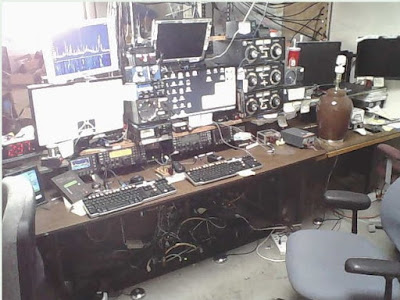 |
| T'was the night BE-4 RTTY |
(both with N6GEO), WQ6X's RTTY RU operations have been more-or-less ho-hum affairs.
The GiGs in 2016 and 2017 run remotely from NX6T in Fallbrook BOTH produced paltry
14k point scores. With some advance preparation in December, my goal was to at least
submit a 1st place log from the San Diego (SDG) section.
Because the RTTY Roundup (RU) contest begins
at 18:00z (10am Pacific time), this gave me the opportunity to setup N1MM+ and MMTTY macros
for NX6T Station #1 on Friday evening and get more-or-less 8 hours of sleep before the event started.
I rarely start a contest right at the 18:00z beginning,
so this year was a unique exception.
Shack heat was a concern during the contest weekend, so the K3 was run into an ACOM 2000a amplifier dialed back to about 550 watts; more than enough to do the job as a high power entry.
Having access to the usual bevvy of antennas at "NashVille" added a few extra DB gain to the 550
watts.
 |
| Making QSO 600 near the end of the contest |
Something that recently occurred to me is that a clever trick when running remote would be to configure a 2nd copy of MMTTY (with different demod settings). or run FLDIGI, on the laptop
end of the connection, routing the IP-Sound audio to the locally-run demodulator as a backup
for deciphering callsigns and QSO #'s.
Unfortunately, software-wise N1MM+ was somewhat of a disappointment this year, resulting in probably 50 CRASH messages throughout the weekend when callsign changes were made before logging a contact. Overall, N1MM+ has been very stable in the last year, so these crash messages were quite surprising.
Propagation-wise, while there were no solar disturbances, with the SFI down to 69, 10 meters never materialized, despite a number of CQ calls while rotating the yagis looking desperately for any 10-meter action. The Reverse Beacon Network reported my callsign on 10 meters but it does no good if everyone is convinced (in advance) that the band is dead so they don't go there.
15 meters produced very little log activity on Saturday, however on Sunday 131 stations were coaxed into the log. 20 meters produced 164 contacts altho I felt more should have been possible. Unfortunately at the bottom of the sunspot cycle, when
20 dies, it dies QUICKLY.
Fortunately, 40 meters came alive
both days "early" in the afternoon. I
was overjoyed to receive calls from EU stations on 40 by 01:00z. On the "Left" coast, we get excited about things like this. Even 80 meters produced a handful of DXCC entries, including SN7 & EA1. Lack of OC and AF continent countries was disappointingly noticeable.
Because there is a maximum of 24 hours OP time allowed out of the 30 contest hours, I managed to fit two sleep periods in (09:00z-12:45z & 14:50z-19:00z), qualifying as OFF time; then again, my total OP time was only 19 hours, leaving me to wonder what I was doing that squandered 5 precious OP hours. In between naps, I managed to add QSOs to the 40 meter log section.
The BiG surprise was NO intentional QRM on 40 meters (which happens nearly every contest). Instead, I encountered what I will call a "BEEPER" on 21090.90 @ 21:08z on Sunday. This
annoying idiot moved around my run frequency +/- making it difficult to put a notch filter on him.
The upside of the 15 meter run was the "pipeline" I experienced to the VE6 world, making up for
the lack of VE6 in most of the 2017 RTTY contests.
The 2018 RTTY RU contest seemed to be lacking in adequate DX activity; not
to mention the RARE states like NE, ME, RI, VT & DC, and of course all the "exotic" eastern Canadian provinces.
Even the 2014 RTTY RU had more DX activity; then again being a DX station myself at that time I guess I shouldn't
be surprised.
When it was all over, a 49k point score was not all that great, but unless I have miscalculated, it is enough to take a 1st place for the San Diego (SDG) section.
Did YOU work the 2018 RTTY RU contest?
Is WQ6X in YOUR log?




No comments:
Post a Comment